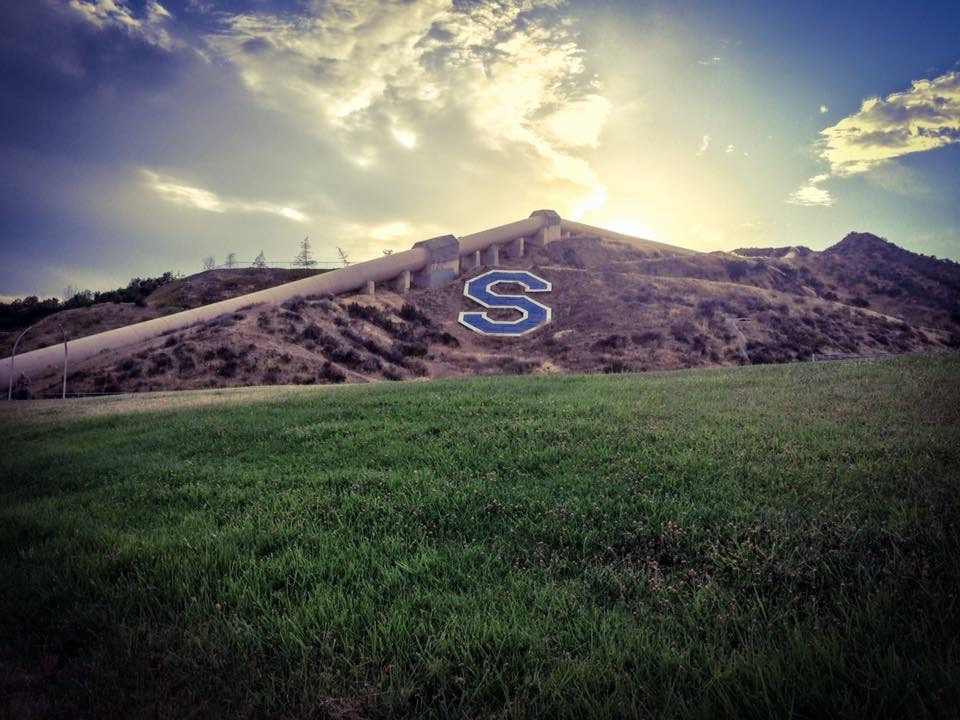The Thin Blue Line flag that caused tension and was essentially banned from being displayed by Saugus High School football players before games has returned, despite the district superintendent and coach calling for the flag to stop flying.
A Saugus High football player carried the Thin Blue Line flag, a black and white replica of the American flag with a single blue line as one of the stripes, in the pregame introductions before the game between Saugus and Golden Valley at College of the Canyons in Valencia on Friday night. Saugus won the game, 31-13.
Both teams earned berths in the CIF Southern Section football playoffs that start on Friday night. Saugus plays Millikan High School from Long Beach in a first-round game at College of the Canyons.
The William S. Hart Union High School District superintendent said last month the Saugus High School football team can no longer use the Thin Blue Line flag at games in its pregame ceremonies, echoing a decision made by the team’s coach.
The decision has created an emotional debate and tensions between members of the community, administrators, school board members, players and students.
Some see the flag as a way to support law enforcement. Others see it as a symbol to combat the Black Lives Matter movement and a symbol used by white supremacist and extremist groups.
Hart district Superintendent Mike Kuhlman said, in a letter sent to the community in September, that use of the flag has become controversial.
“Just three short days ago, I became aware of a concern about this symbol being flown at Saugus High School football games,” Kuhlman wrote in the letter dated Sept. 28. “Despite emails for immediate action, and threats of consequences if certain steps weren’t taken within a specific timeline, we determined to take our time to understand the issue accurately and to respond thoughtfully.”
Saugus High Principal Geni Peterson Henry told the Los Angeles Times in September she met with football coach Jason Bornn, who said he “was not even fully aware of the banners in question” and added that the team did not agree to using the flag before games.
“…(It) occurred to (Bornn) that it’s possible that some players on the team might not be entirely enthusiastic about a symbol that is being used to represent the entire team,” Kuhlman wrote.
Bornn decided to discontinue the use of the flag “in deference to his commitment to inclusivity, kindness and respect…” the Times reported.
Kuhlman wrote in his letter to the community that the district is exploring alternative methods to show support for law enforcement.
“Please note that this decision does not translate into a change in support for law enforcement,” Kuhlman wrote. “The degree of enthusiasm behind our District’s backing of law enforcement is not measured by the acceptance or rejection of any one particular symbol.”
Hart school board president Joe Messina said during a board meeting in September it was insulting for the district to decide not to let the team use the flag.
“I believe, personally, this is a slap in the face of those who came running towards danger at Saugus High School,” Messina said.
Saugus High was the site of a deadly mass shooting in 2019. The students and some members of the football team at Saugus High were freshmen when the shooting happened. It resulted in three student deaths and two wounded students. The gunman shot himself to death before law enforcement arrived at the school.
Speakers from the community at a school board meeting last month expressed their support and opposition to the decision.
One speaker, who said she was a 28-year veteran of the LAPD, said she was dismayed and upset with the decision to stop using the flag.
Another speaker, a parent of students in Saugus public schools, said there were “a thousand other ways” to show support of law enforcement.







